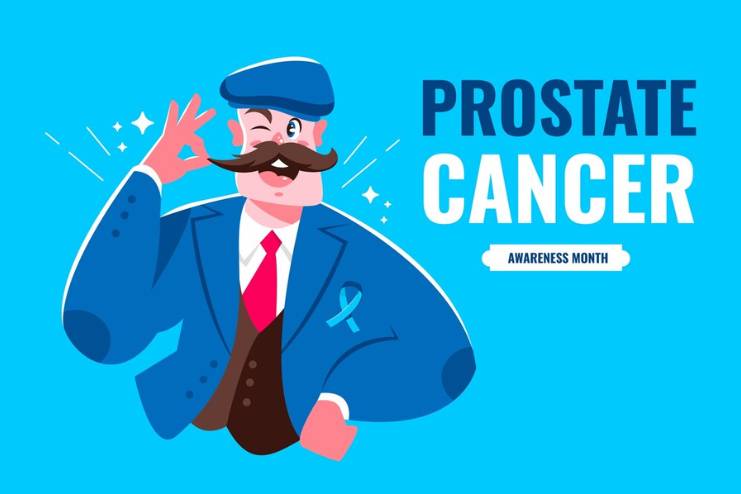Affiliate Disclaimer
Some links in this article are affiliate links. We may earn a small commission if you make a purchase through these links, at no extra cost to you. We only recommend products we find useful to our readersProstate cancer is the most common cancer among men, with over 280,000 new cases expected this year. Although survival rates have improved due to better screening and treatments, more awareness is needed for early detection. Prostate Cancer Awareness Month, every September, helps by raising public awareness, encouraging screening, and supporting research to fight this disease.
This month highlights the ongoing challenges and progress in managing prostate cancer. It serves as a reminder of those affected and the efforts to combat the disease. Despite advances, disparities in outcomes still exist among different groups. Prostate Cancer Awareness Month is a chance for us all to reflect and take action in the fight against this widespread disease.
History of Prostate Cancer Awareness Month

Due to this, Prostate Cancer Awareness Month was adopted to bring awareness and encourage early detection. Officially recognized in September 2003 by President George W. Bush, it encourages men, specifically those over the age of 50, to get screened and consult with their doctors.
The fight against prostate cancer gained momentum with the discovery of the PSA (Prostate-Specific Antigen) test back in the 1930s and active screening in the 1980s and 1990s. There was greater awareness among the public and treatment modalities became more positive.
There are many contemporary challenges, like the rising incidence in certain parts of the world and different outcomes based on demographics. Prostate Cancer Awareness Month has been directly or indirectly playing an important role in recent years in increasing awareness, supporting research, and advocating for better care.
The Evolution of Prostate Cancer Treatment

Treatment for prostate cancer has advanced significantly over time. Here’s the key milestones:
Early Treatment
The discovery of radium and polonium was in 1898, and the first uses of radium in prostate cancer treatment came into being. These treatments were painful and did not come into wide use. The first radical prostatectomy with intent to remove the prostate gland was performed by Hugh Hampton Young in 1904, with modest success.
Mid-20th Century
The big breakthrough came in the mid-20th century. In 1938, a marker for the detection of prostate cancer was found. In 1941, there was the introduction of hormone therapy that delayed cancer growth. In 1945, a new surgical technique improved cancer staging.
Modern Era
It was in the latter half of the 20th century that further development with external beam radiotherapy (EBRT) as a non-invasive treatment caused further improvements in survival rates. The screening with PSA in the 1980s and 1990s led to the earlier detection of the disease, hence better results. In the 1990s, the introduction of laparoscopic prostatectomy and, in 2001, robotic-assisted prostatectomy made the surgical procedures less invasive and more accurate, with shorter recovery times and fewer complications.
Current Treatments
Treatments are becoming increasingly targeted with precision medicine today. Advanced imaging techniques, like multiparametric MRI, help detect and stage these conditions. New hormone therapies and immunotherapies give new hope to those at an advanced cancer stage. Access to these various treatments is not easy, and efforts continue to ensure that they become more available and affordable.
The Impact of Prostate Cancer Awareness Month

Prostate Cancer Awareness Month is essential for raising awareness, promoting education, and supporting research on prostate cancer.
Objectives:
- Increase Awareness: Educate the public about prostate cancer, its risk factors, and the need for regular screening.
- Promote Early Detection: Urge men over 50 or those with a family history of prostate cancer to discuss screening with their healthcare providers.
- Support Research: Raise funds for research into better treatments, early detection methods, and a potential cure.
- Advocate for Policy Changes: Support efforts to improve cancer care, ensure equitable access to treatments, and enhance funding for research.
Impact on Public Awareness and Screening: Prostate Cancer Awareness Month has significantly improved public knowledge and early detection rates. It helps:
- Educate Men and Families: Provide essential information about the risks and benefits of early detection.
- Increase Screening Rates: Boost PSA testing and other screening methods.
- Promote Healthy Behavior: Encourage regular check-ups and healthy lifestyle choices.
Supporting Research and Policy Change: The month also impacts research and policy by:
- Funding Research: Donations and events finance research for better treatments and screening methods.
- Legislative Support: Drives policy changes and increases funding for research and patient support, including improved insurance coverage for innovative treatments.
Addressing Disparities and Inequities: A key focus is addressing health disparities, especially among Black men, who face higher death rates from prostate cancer. Awareness campaigns aim to:
- Highlight Disparities: Draw attention to increased risks and advocate for tailored research and intervention strategies.
- Expand Access to Care: Promote access to screening, treatment, and support services for underserved communities.
Current Challenges and Future Directions

While Prostate Cancer Awareness Month and other campaigns forge ahead, there are still many continuing challenges. Here’s a look at these ongoing issues and potential future directions.
Challenges in Prostate Cancer Management
- Early Detection and Screening
- Variability in Guidelines: The optimal age and frequency for prostate cancer screening remain debated. While PSA testing has improved early detection, it has limitations, including false positives and the potential overdiagnosis of cancers that may not require treatment.
- Access Disparities: Screening and diagnostic services are unevenly distributed, especially in underserved communities. Ensuring equitable access to prostate cancer screening is crucial.
- Treatment Options and Side Effects
- Side Effects of Treatments: Treatments such as surgery, radiation, and hormone therapy can lead to significant side effects, including sexual dysfunction, incontinence, and fatigue. Managing these side effects and improving quality of life for patients remains challenging.
- Treatment Personalization: Prostate cancer varies widely among patients. Developing personalized treatment plans based on individual characteristics and cancer profiles is a key focus.
- Survivorship and Support
- Long-Term Effects: Survivors often face long-term health issues and psychological challenges. Comprehensive survivorship care, including physical, emotional, and social support, is essential but sometimes lacking.
- Support Systems: Patients and families may struggle with navigating cancer care complexities, including financial strain and access to support services.
Future Directions and Opportunities
- Advancements in Screening and Early Detection
- Improved Biomarkers: Research is ongoing to identify new biomarkers and imaging techniques for better early detection and risk assessment. Genetic testing and advanced imaging technologies offer promising advancements.
- Personalized Screening Guidelines: Future guidelines may adopt a more personalized approach to screening based on individual risk factors, family history, and genetic predispositions.
- Enhancements in Treatment
- Targeted Therapies: Research into targeted therapies and immunotherapy aims to provide more effective and less invasive treatment options, focusing on specific molecular targets related to prostate cancer cells.
- Minimally Invasive Techniques: Advances in minimally invasive surgical techniques, such as robotic-assisted surgery, aim to reduce side effects and improve recovery times.
- Support and Education
- Patient Education: Expanding educational efforts to offer comprehensive information about prostate cancer, treatment options, and support resources can empower patients and families.
- Support Networks: Strengthening support networks, including patient advocacy groups and community resources, can provide essential emotional and practical support.
- Addressing Health Disparities
- Targeted Outreach: Addressing health disparities, particularly among high-risk populations such as Black men, is crucial. Targeted outreach, education, and support programs should be tailored to these communities.
- Policy Advocacy: Advocating for policies that ensure equitable access to care, research funding, and support services is essential to addressing systemic inequities in prostate cancer outcomes.
How to Get Involved and Support Prostate Cancer Awareness

The month is all about prostate awareness, funding research for finding a cure, and showing support for the victims. Here’s how you can easily make a difference:
- Educate Yourself and Others
- Learn About Prostate Cancer: Understand the risks, symptoms, and treatments by checking reliable sources like cancer organizations and medical professionals.
- Spread Awareness: Share information about prostate cancer and its early detection with friends, family, and on social media.
- Participate in Awareness Campaigns
- Join Events: Take part in walks, runs, and seminars organized during the month to raise awareness and funds.
- Wear Awareness Gear: Show support by wearing blue and participating in related activities.
- Support Research and Advocacy Efforts
- Donate: Give to organizations like the Prostate Cancer Foundation or the American Cancer Society that fund research and patient support.
- Advocate for Policy Change: Support policies that fund research and improve care by contacting legislators and participating in advocacy efforts.
- Encourage Screening and Preventive Measures
- Promote Screening: Encourage men, especially those over 50 or at higher risk, to talk to their doctors about screening.
- Support Preventive Programs: Advocate for and join programs that provide screening and education to underserved communities.
- Volunteer and Support Local Initiatives
- Volunteer: Offer your time to local organizations and support groups to help with events and patient support.
- Support Local Efforts: Engage with community initiatives and support groups for a more personal impact.
- Offer Emotional and Practical Support
- Support Those Affected: Reach out to friends or family affected by prostate cancer with practical help and emotional support.
- Join Support Groups: Participate in or facilitate support groups for sharing experiences and encouragement.
Conclusion
Prostate Cancer Awareness Month is dedicated to raising awareness, progressing research, and standing in support of men who have been suffering from this disease. The period reflects both on the progress made in early detection and treatment and on the challenges to be overcome.
The month is devoted to highlighting the need for continued education, advocacy, and support. Indeed, increased awareness has translated to better detection and improved patient outcomes; however, disparities in care persist. Addressing these gaps requires ongoing commitment to equity and access.
Getting involved in Prostate Cancer Awareness Month actually makes a difference. Educating, taking part in campaigns, supporting research, encouraging screenings, and giving support are the various ways one may contribute in combating prostate cancer.
Together, we will beat prostate cancer, remember those diagnosed with this disease, and ensure that proper treatment becomes accessible.
References
- https://www.pacehospital.com/prostate-cancer-awareness-month
- https://accounts.haymarketmedia.com/authcheck?gn=101
- https://www.federalregister.gov/documents/2023/09/06/2023-19329/national-prostate-cancer-awareness-month-2023
- https://www.whitehouse.gov/briefing-room/presidential-actions/2024/08/30/a-proclamation-on-national-prostate-cancer-awareness-month-2024
- https://www.aacr.org/patients-caregivers/awareness-months/prostate-cancer-awareness-month
In this Article




















